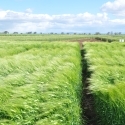17 Sep 2013
Pasture Nutritional Constraints
Perennial Pasture Systems, September, 2013

Pasture Nutritional Constraints – are we missing something?
Rob Norton, International Plant Nutrition Institute.
Perennial pastures represent a challenging task for plant nutrition for a number of reasons. Firstly, these pastures are mixtures of species either by design or by management, and the composition changes in both space and time. As a result, the demand for the amount and type of nutrient changes. Secondly, the pattern of rainfall (in particular) determines the sorts of losses of nutrients, so the amount supplied can also vary seasonally. And thirdly, every action in a perennial system has a reaction – grazing patterns affects productivity, pasture species affects pasture supply, short term changes result in long term changes.
To deal with such complexity, it is important to go back to check the basics in a nutrition program. In any system, you get nothing for nothing - input and out put have to be balanced. Secondly, nutrient management needs to address the limiting factor – if waterlogging, disease or soil pH are limiting, then these factors need to be addressed so the climatic limits for plant productivity are met. Finally, there are no silver bullets, no miracle products and no shortcuts.
A good nutrition program will seek to match the right product, applied at the right rate, at the right time and put in the right place – these are the four “rights’ or 4R’s of nutrient management. Selecting the combination of source, rate, time and place is complex and even more so when the system is a dynamic perennial pasture. Despite the complexity, there are a few touchstones to come back to with pasture nutrition.
1. Start with the soil
a) get the pH right for the main species. Read the pasture for signs of acidification and look to soil testing to see if aluminium or manganese toxicity are likely. At low pH, molybdenum in particular can be deficient, and some of the liming effect can be an improvement in molybdenum availability alone.
b) Get the structure and drainage right – using gypsum and/or draining may be important. Organic matter is important as a soil nutrient buffer but good pasture management should result in good soil organic matter content – it is – in my opinion – an indicator rather than a target.
c) Cation ratios in the soil are no indication of soil fertility, soil health or soil structure. Forget them, but actual levels of cations are important.
2. Get Phosphorus right
a) For many soils low soil P is still a problem, and one that has had some great tools developed to address such as the “5 Easy Steps”. Soil testing using Colwell P or Olsen P is reliable in as a indicator of where the P fertility is going. Good P nutrition will favor good pasture legumes, which in turn provide good biological N input.
b) Operating above the critical P range is not efficient as more of the applied P ends up in the low availability pools and do not contribute to productivity. If the soil P test value is at the critical value, balance input and losses (product removal, losses to the environment, and soil P demand).
c) Soluble P sources provide the most responses, although there are some limited situations – especially very acid soils - where less soluble P sources can provide benefits.
3. Sulfur and potassium need thought
a) P status is not a measure of other nutrients – for example soil S status is largely unrelated to soil P status. This is because S is mobile while P in largely immobile. While elemental S can be useful in some situations, having a soluble S source is important.
b) It is clear that soil K status is declining in some areas, and soil test status is relatively low in high rainfall areas. K removal is highest where hay is cut on lighter soils, and these paddocks are the first indicators of K rundown.
c) K applications can reduce pasture Mg levels and result in grass tetany and milk fever in cattle. Timing of grazing has a major effect.
4. Nitrogen can help fill the feed gaps
a) In most dryland situations soil N is usually sufficient during the warmer months, supplied by minerlisation. Pastures will only respond to additional N when N is the limiting factor – adding N to a waterlogged pasture in the middle of winter or to a droughted pasture in early autumn will not give a response.
b) Small doses (20-50 kg N/ha) applied to grass dominant pastures in periods when clover growth is low – such as May-September or June/July. There are alternative forms of N that can help reduce losses. But make sure if you grow the grass, there is something profitable to eat it.
5. Micronutrients
a) Micronutrients for plants – Zn, Cu, Mn, B, Mo are all important. Soil pH is a key driver especially for Mo. Low Cu can occur where high Mn and S levels are present, B deficiency can occur after liming. For Cu, animal symptoms occur before plant growth is significantly impacted. Low rates every few years are enough.
b) Micronutrients for animals – Co, Se.
c) Micronutrient deficiencies in pastures are not common, mainly because of low offtake in grazed pastures. Soil tests are of limited value in diagnosis
So, are we missing something? If your reseller thinks so, ask for the evidence such as low tissue tests or results from strip trials in YOUR paddocks. Then seek reliable field evaluations of product efficacy. Be objective and critical – it is your money and your business after all.
Additional Resources
Slides From PresentationSize: 12.8 MB




